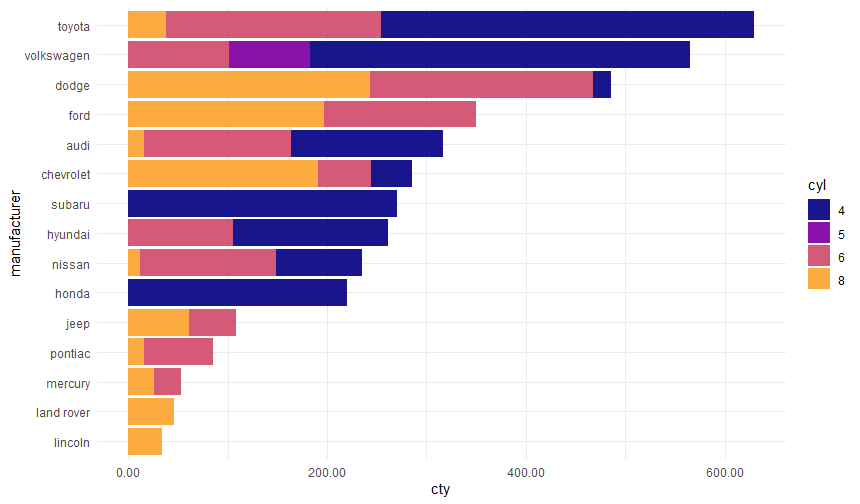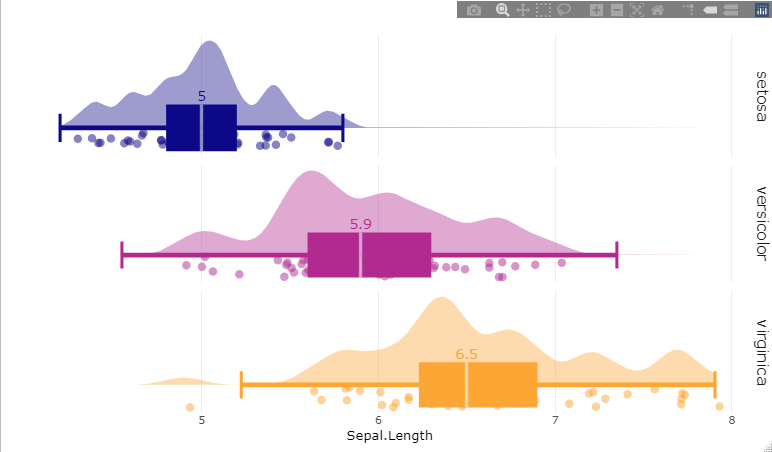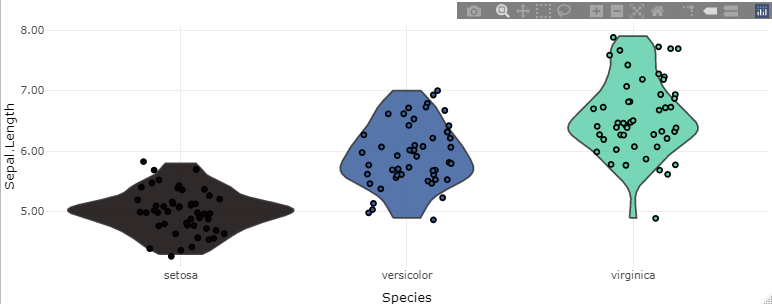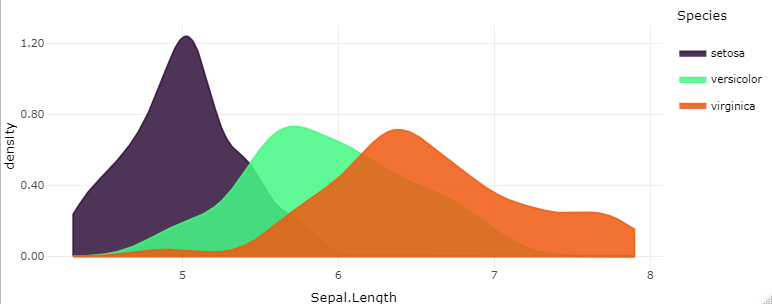R package to create R Markdown reports with a sequential syntax inspired by ggplot
{chronicle}
2021-06-24
An R package for easy R Markdown reporting
install.packages('chronicle')
This R package aims to be an opinionated assistant, to whom you can
delegate the task of creating visually appealing and consistent R
Markdown reports.
A quick demo
The way you build the reports is by specifying the structure of your
report through the add_* family of functions, layering one below the
previous one.
library(chronicle)
demo_report <-
add_text(text_title = "This is the output of a chronicle call",
text = "Each element has been added through an `add_*` function.",
title_level = 1) %>%
add_table(table = head(iris),
table_title = "A glimpse of the iris dataset",
html_table_type = "kable",
title_level = 1) %>%
add_raincloud(dt = iris,
value = "Sepal.Length",
groups = "Species") %>%
add_scatterplot(dt = iris,
x = "Petal.Width",
y = "Petal.Length",
groups = "Species")
render_report(report = demo_report,
title = "A quick chronicle demo",
filename = "quick_demo",
keep_rmd = TRUE)
You can see the output of this
call, and a
full showcase of
all the elements supported by chronicle.
What happens behind these calls is that chronicle literally wirtes the
content of an R Markdown for you! You can see the content of the report
by directly printing it.
demo_report
# This is the output of a chronicle call
Each element has been added through an `add_*` function.
# A glimpse of the iris dataset
```{r, echo=FALSE, message=FALSE, warning=FALSE}
knitr::kable(head(iris))
```
## Distribution of Sepal.Length by Species
```{r, echo=FALSE, message=FALSE, warning=FALSE, fig.width=params$figure_width, fig.height=params$figure_height}
chronicle::make_raincloud(dt = iris,
value = 'Sepal.Length',
groups = 'Species',
adjust = 0.5,
include_boxplot = TRUE,
include_mean = FALSE,
include_median = TRUE,
force_all_jitter_obs = FALSE,
ggtheme = 'minimal',
plot_palette = params$plot_palette,
plot_palette_generator = params$plot_palette_generator,
static = params$set_static)
```
## Petal.Width vs Petal.Length by Species
```{r, echo=FALSE, message=FALSE, warning=FALSE, fig.width=params$figure_width, fig.height=params$figure_height}
chronicle::make_scatterplot(dt = iris,
x = 'Petal.Width',
y = 'Petal.Length',
groups = 'Species',
plot_palette = params$plot_palette,
plot_palette_generator = params$plot_palette_generator,
static = params$set_static)
```
The make_* family of functions
Every plot added with an add_* function will be built through its
correpsonding make_* function. These functions take care of the heavy
lifting, avoiding the cumbersome (albeit powerful) sintax of ggplot,
plotly and other html widgets. The parameters of the make_functions are
simple and intuitive specifications on how to make each plot, and they
can be called independently and used in any instance where a ggplot or
an html widget would fit.
make_barplot(dt = ggplot2::mpg,
value = 'cty',
bars = 'manufacturer',
break_bars_by = 'cyl',
horizontal = TRUE,
sort_by_value = TRUE,
static = TRUE)

make_raincloud(dt = iris,
value = 'Sepal.Length',
groups = 'Species')

Rendering chronicle reports
Once the structure of the report has been defined, the rendering process
is done by render_report(). This uses rmarkdown::render() as a
backend for rendering the report, which gives chronicle the capability
to render the reports with full visibility to all objects in the global
environment. This gives chronicle two of big strengths:
-
You don’t need to include nor run all your data processing code
again for a new report output. This means you can build several
report recipes for different audiences out of the same data
processing, rendering all of them from the same global environment. -
It can render several output formats in a single call. For
instance, it is possible to render the same content as
ioslides
for a presentation, as
tufte_html for handouts and as
rmdformats for a site upload.
Take our quick demo as an example, to render this as the three outputs
mentioned previously, you only need to add that vector to the
output_format parameter of render_report()
render_report(report = demo_report,
output_format = c("ioslides", "tufte_html", "rmdformats"),
filename = "quick_demo",
title = "A quick chronicle demo",
author = "You did this!",
include_date = FALSE,
fig_width = 8,
fig_height = 6,
plot_palette = c("#FC8D59", "#FFFFBF", "#99D594"),
plot_palette_generator = "plasma",
rmdformats_theme = "readthedown",
keep_rmd = TRUE)
The render_report function allows the user to specify several global
parameters of the report, like fig_width, fig_height,
plot_palette, and plot_palette_generator. This last one specifies
which palette from the
viridis
package will be used to complete insufficiently long palettes (or when
the user did not specify a palette at all.)
make_violin(dt = iris,
value = 'Sepal.Length',
groups = 'Species',
plot_palette_generator = 'mako')

make_density(dt = iris,
value = 'Sepal.Length',
groups = 'Species',
faceted = FALSE,
plot_palette_generator = 'turbo')

The report_columns() function
chronicle also includes a function called report_columns(), that will
create an entire chronicle report for a single dataset. It includes a
comprehensive summary of the data through the skimr::skim() function,
along with one plot for each column present in the data: bar plots for
categorical variables and rain cloud plots for numerical variables. This
gives you an immediate view of a dataset with a single line of code!
report_columns(dt = palmerpenguins::penguins,
by_column = 'species')
And you can see the output of this
call
Supported formats
As of version 0.2.5, chronicle can output both static and dynamic
outputs. Dynamic outputs refer to R Markdown formats that support html
widgets, hence the elements added will be dynamic plots (plotly,
dygraph, DT). For static outputs, these will roll back to ggplot and
static table prints. To avoid large file sizes, it will also roll back
to static plots if the table has over 10,000 rows.
Dynamic outputs (html)
- bookdown
- github_document (you are reading one right now!)
- html_document
- html_notebook
- ioslides
- prettydoc
- rmdformats
(this is currently the default) - slidy_presentation
- tufte_html
Static outputs
Additionally,
{flexdashboard} and
{xaringan} technically compile,
but the layout is stiff in flexdashboard and altogether incorrect in
xaringan, so you might still use it if you don’t mind manually
correcting the separators. Also,
{rticles} support can technically
be added, but that would involve a plethora of additional parameters for
the header, and frankly, writing a journal article is not the intended
use of the package
Supported report elements
I highly encourage you to review the enitre
showcase, words
are not as adequate to describe each element. But for a quick glance, as
of version 0.2.5 chronicle supports:
- Bar plots
- Box plots
- Code (optionally evaluated)
- Density plots
- Dygraphs
- Histograms
- Line plots
- Rain cloud plots
- Scatter plots
- Tables
- Texts
- Titles
- Violin plots